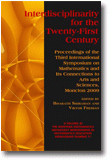
Interdisciplinarity for the 21st Century
Proceedings of the 3rd International Symposium on Mathematics and its connections to the Arts and Sciences, Moncton 2009
Edited by:
Bharath Sriraman, University of Montana
Viktor Freiman, University of Moncton
A volume in the series: The Montana Mathematics Enthusiast. Editor(s): Bharath Sriraman, University of Montana.
Published 2010
Interdisciplinarity has become increasingly important for emergent professions of the 21st century yet there is a dearth of systematic studies aimed at implementing it in the school and university curricula. The Mathematics and its Connections to the Arts and Sciences (MACAS ) group places Mathematics as a vehicle through which deep and meaningful connections can be forged with the Arts and the Sciences and as a means of promoting interdisciplinary and transdisciplinary thinking traits amongst students. The Third International Symposium held by the MACAS group in Moncton, Canada in 2009 included numerous initiatives and ideas for interdisciplinarity that are implementable in both the school and university setting. The chapters in this book cover interdisciplinary links with mathematics found in the domains of culture, art, aesthetics, music, cognition, history, philosophy, engineering, technology and science with contributors from Canada, U.S, Denmark, Germany, Mexico, Iran and Poland amongst others.
CONTENTS
Introduction: Interdisciplinary Networks for Better Education in Mathematics, Science, and the Arts, Viktor Freiman and Bharath Sriraman. Intercultural Positioning in Mathematics, David Wagner. History in Mathematics Education—Why Bother? Interdisciplinarity, Mathematical Competence, and the Learning of Mathematics, Tinne Hoff Kjeldsen. The Role of the Aesthetic in Mathematical Problem Solving, Nathalie Sinclair and Christian Berneche. Mathematics in the Everyday World and at Work: Prolegomena for Rethinking the Concept of Interdisciplinarity, Wolff-Michael Roth. A Portrait on How Groups of Elementary Age Students in a French Language Minority Setting Pose an Environmental Problem, Viktor Freiman, Diane Pruneau, Joanne Langis, Pierre-Yves Barbier, Marianne Cormier, and Monique Langis. Teaching Citizenship Education Through the Mathematics Course, Annie Savard. Flow: An Emotional Experience in Mathematics Problem Solving, T. Seifert, O. Radu, and A. Doyle. Learner Directed Opportunities Through Adaptive Hypermedia Systems, Adnen Barhoumi and Chadia Moghrabi. Quantitative Reasoning as a Tool for Understanding, Natalya Vinogradova. Interdisciplinarity Through Processes of Modeling and Sociomathematical Decision Making, Claus Michelsen and Jan Alexis Nielsen. Do Mathematical Laboratories Enhance Primary School Students' Hands-On Learning Experiences? Mark Applebaum and Viktor Freiman. Amazing Math-Science-Arts Connections: Getting Insight Into the Golden Ratio, Dominic Manuel, Viktor Freiman, Edel Reilly, Ildiko Pelczer, Natalya Vinogradova, Bharath Sriraman, and Astrid Beckmann. Mathematics in Contemporary Art, Nathalie Sayac. Advancing the Concept of Variables Through Cross-Curricular Stations Between Arts and Mathematics Instruction, Astrid Beckmann. Visual Arts and Mathematics: Intertwining for a New Conversation in Education, Lise Robichaud. Why is a Negative × a Negative = a Positive? Possible Benefits of Interdisciplinarity, Polotskaia Elena. Writing + Math = Opportunity: Forging New Interdisciplinary Connections, Edel M. Reilly. Study of the Potential of the Use of Degrees of Certainty to Provide the Common Sense with an “Alert Bell”, Sophie René de Cotret, Manon LeBlanc, and Réal Larose. Visuo-Dynamic Learning: How Does the Net Generation Learn? Zekeriya Karadag. Online Video Technology as Enabler for Teaching and Learning Multidisciplinary Topics, Dragana Martinovic. Directional Pitch Spaces, Ilhan M. Izmirli. A Note on Fibonacci Numbers in Music, Larry G. Blaine. Robotic-Based Learning: RoboMaTIC, Samuel F. J. Blanchard. NET Generation: Social Media and its Link to Interdisciplinarity, Samuel F. J. Blanchard. A City Built on Geometry: Project-Based Learning in a Grade 10 Math Classroom, Marcia Cormier. Plato’s Timaeus and the Intervals Used in Traditional Music of the Middle Classroom, Amirhossein Damadi and Payam Seraji. Using Origami as Context Builder to Teach (Pre)Math Skills, Ildikó Pelczer. Are There Mathematical Phenomena? Herbert Gerstberger. Mathematical Literacy and How Scientific Experiments Can Promote That Conception, Simon Zell. Cross-Curricular Teaching between Mathematics and Biology—Nutrition Circle, Similarity, and Allometry, Astrid Beckmann and Annika Grube. A Call for Integrating Engineering Through Cooperative Learning in the Mathematics and Science Teacher Education Program, Ke Wu Norman, Anne L. Kern, and Tamara J. Moore. Choosing to Study Mathematics and Science Beyond the Classroom: Who Participates and Why? Karen Sullenger and Viktor Freiman. A Brief History and Exploration of Some Didactic Journeys to Connect the Great Continents of Knowledge, Alan Rogerson. Some Remarks on the Comparison Between Mathematical and Poetical Facts/Events, Romualdas Kašuba.
-
Paperback978-1-61735-218-8
Web price: $62.04 (Reg. 72.99)
-
Hardcover978-1-61735-219-5
Web price: $89.24 (Reg. 104.99)
- eBook9781617352201

-
 Critique as Uncertainty
Critique as Uncertainty
-
 Crossroads in the History of Mathematics and Mathematics Education
Crossroads in the History of Mathematics and Mathematics Education
-
 Selected writings from the Journal of the British Columbia Association of Mathematics Teachers
Celebrating 50 years of Vector
Selected writings from the Journal of the British Columbia Association of Mathematics Teachers
Celebrating 50 years of Vector
-
 Selected writings from the Journal of the Mathematics Council of the Alberta Teachers' Association
Celebrating 50 years (1962-2012) of delta-K
Selected writings from the Journal of the Mathematics Council of the Alberta Teachers' Association
Celebrating 50 years (1962-2012) of delta-K
-
 Selected Writings from the Journal of the Saskatchewan Mathematics Teachers' Society
Celebrating 50 years (1961-2011) of Vinculum
Selected Writings from the Journal of the Saskatchewan Mathematics Teachers' Society
Celebrating 50 years (1961-2011) of Vinculum
-
 The Development of Teaching Expertise from an International Perspective
The Development of Teaching Expertise from an International Perspective
-
 The Role of Mathematics Discourse in Producing Leaders of Discourse
The Role of Mathematics Discourse in Producing Leaders of Discourse

